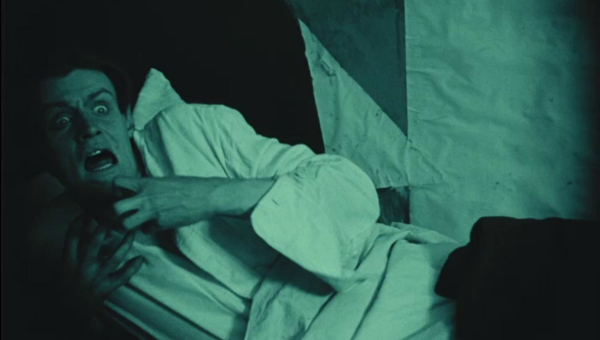
German Expressionist masterpiece of the silent era, THE CABINET OF DR CALIGARI (Das Cabinet des Dr. Caligari), has been described as the first horror film. Nearly a century after it was made, it remains unsettling and fascinating. Thanks to a two-year digital restoration project, modern audiences can now appreciate its vivid faces and mindbending sets in fresh cinematic clarity.
Directed by Robert Wiene from a screenplay by Hans Janowitz and Carl Mayer, THE CABINET OF DR CALIGARI was groundbreaking in many ways. It features one of the earliest examples of a ‘frame story’, in which most of the plot is presented as a flashback told by the main character. Stylised sets – which included models of abstract, jagged buildings, painted shadows, and cut-out trees – were an attempt to show the psychological disturbance suffered by the film’s characters. Caligari also has a satisfyingly dark ‘twist’ ending, an innovation in 1920.
At night Cesare is woken by Caligari to do his dastardly bidding…
During the opening sequence Francis (Friedrich Fehér) is sitting on a park bench chatting to a companion, when a seemingly distracted woman, Jane (Lil Dagover), passes by. Francis calls her his ‘fiancée’, and narrates their disturbing story, which begins with a visit to a local fair to watch the double-act of Dr Caligari (Werner Krauss) and his panda-eyed somnambulist Cesare (Conrad Veidt). Caligari wakes his sleepwalker from his dream-like trance so he can tell the audience their fortune, and when Francis’s friend Alan asks ‘how long will I live?’ he is told: ‘to the break of dawn’. At night Cesare is woken by Caligari to do his dastardly bidding, and so begins a series of shadowy murders and abductions, which lead to paranoia and mental disintegration.
Audience jitters are reinforced by stark, discordant music (a new score by the Hochschule für Musik), featuring high-pitched organ, hectic violins, plinking piano and Psycho cello. In the Silent world of dramatic expression and gesture, Werner Krauss is riveting as Doctor Caligari. Sinister and goggle-eyed, he pulls splendidly grotesque faces, sometimes reminiscent of Father Jack from Father Ted. When he unveils a life-sized painting of his sleep-walker, a poster to advertise his act, Cesare’s sunken cheeks resemble Munch’s figure in The Scream.
…bent lamp-posts, pointy hats and a crazy-paving mosaic of a village…
Modern viewers might find the ‘horror’ elements in the film a bit lame; this ‘psychological thriller’ less than thrilling. But there are so many aspects of Caligari to enjoy, beyond any conventional genre criteria. Apart from its celebrated sets, created by designer Hermann Warm and painters Walter Reimann and Walter Röhrig, the film’s hand-written titles are works of art in themselves – dagger-shaped glow-in-the-dark green letters, over ‘broken glass’ backgrounds. In this off-kilter world, it’s fun to play ‘spot the weird’– an outsize polka-dot bowtie here, a Dali-esque chaise longue there; bent lamp-posts, pointy hats and a crazy-paving mosaic of a village that clearly influenced Walt Disney’s design for his Night on Bald Mountain section in FANTASIA.
You also notice the colour changes for various scenes – sepia-tinted for ‘normal’, blue-green at night, pinkish for Jane’s bedroom. This tinting of the film was one of the most striking changes effected by the new digital cinema quality (4K) restoration by Germany’s Friedrich Wilhelm Murnau Foundation. Restorer Anke Wilkening got rid of scratches and dirt from the film’s negative and added hundreds of missing frames, so that the new version is ‘a quantum leap’ ahead of previous attempts at restoration and remastering. ‘We have all the details in the frames,’ she says, ‘all the shades of grey, all the detail in the faces.’ THE CABINET OF DR CALIGARI no longer looks like ‘a dusty old film.’
2014 Kino Classics Blu-ray Disc edition is available now. DVD release date: 18 November 2014.
httpvh://youtu.be/IAtpxqajFak

